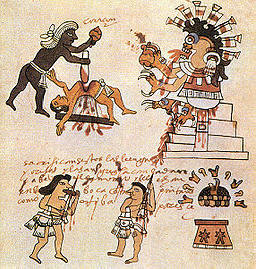Human Sacrifice In Aztec Culture From Wikipedia, the free encyclopedia
Human sacrifice was an aspect of historical Aztec culture/religion, although the extent of the practice is debated by scholars. The Spaniards who first meet the Aztecs explicitly stated in their writings that human sacrifice was widely practiced in Mesoamerica. For example, Bernal Díaz's The Conquest of New Spain includes eye-witness accounts of the remains of sacrificial victims. In addition, there are a number of second-hand accounts of human sacrifices written by Spanish friars, told to them by native eye-witnesses.
Presently, scholars largely accept that human sacrifice was practiced in the Aztec Empire as well as throughout pre-Columbian Mesoamerica. Since the late 1970s, excavations of the offerings in the Great Pyramid of Tenochtitlan, Teotihuacán's Pyramid of the Moon and other archaeological sites have provided physical evidence of human sacrifice among the Mesoamerican peoples.[1][2][3]
A wide number of interpretations of the Aztec practice of human sacrifice have been proposed by modern scholars, both with regards to its religious and social significance. For example, one theory that has been widely discredited is that the Mesoamerican diet was lacking protein and that cannibalism of sacrificial victims was a necessary part of the Aztec diet.[4] Other theories link the practice to special socio-psychological factors or see it as a political tool. Most Mesoamerican scholars, however, see it as a part of the millennia-long cultural tradition of human sacrifice in Mesoamerica.
Human sacrifice among pre-Columbian indigenous populations is a controversial topic. The discussion of human sacrifice is also tied with the classic conflict between viewing indigenous peoples as either "noble savages" or "primitive barbarians" also within modern scholarship, where some scholars tend to romanticize the description of human sacrifice while others tend to exaggerate it.[5]
The antecedents of Mesoamerican sacrifice
The practice of human sacrifice was widespread in the Mesoamerican and in the South American cultures during the Inca Empire.[6][7] Like all other known pre-Columbian civilizations of Mesoamerica, the Aztecs practiced human sacrifice. The extant sources describe how the Aztecs sacrificed human victims on each of their eighteen festivities, one festivity for each of their 20-day months.[8] It is unknown if the Aztecs engaged in human sacrifice before they reached the Anahuac valley and started absorbing other cultural influences. The first human sacrifice reported in the sources was the sacrifice and skinning of the daughter of the king Cóxcox of Culhuacán; this story is a part of the legend of the foundation of Tenochtitlan.[9] Several ethnohistorical sources state that under the guidance of Tlacaelel the importance of human sacrifice in Aztec history was given extra emphasis.
The role of sacrifice in Mesoamerica
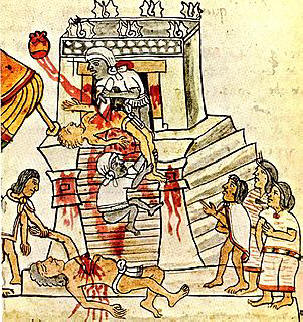 Human sacrifice as shown in the
Codex Magliabechiano
Human sacrifice as shown in the
Codex Magliabechiano
Sacrifice was a common theme in Mesoamerican cultures. In the Aztec "Legend of the Five Suns", all the gods sacrificed themselves so that mankind could live. Some years after the Spanish conquest of Mexico, a body of Franciscans confronted the remaining Aztec priesthood and demanded, under threat of death, that they desist from their murderous practice. The Aztec priests defended themselves as follows:
Life is because of the gods; with their sacrifice they gave us lifeThey produce our sustenance which nourishes life.[10]
What the Aztec priests were referring to was a central Mesoamerican belief: that a great, on-going sacrifice sustains the Universe. Everything is tonacayotl: the "spiritual flesh-hood" or "bodily [sacrificial] presence" of the gods on earth. Everything —earth, crops, moon, stars and people— springs from the severed or buried bodies, fingers, blood or the heads of the sacrificed gods. Humanity itself is macehualli, "those deserved and brought back to life through penance".[11] A strong sense of indebtedness was connected with this worldview. Indeed, nextlahualli (debt-payment) was a commonly used metaphor for human sacrifice, and, as Bernardino de Sahagún reported, it was said that the victim was someone who "gave her service".
Human sacrifice was in this sense the highest level of an entire panoply of offerings through which the Aztecs sought to repay their debt to the gods. Both Sahagún and Toribio de Benavente (also called "Motolinía") observed that the Aztecs gladly parted with everything: burying, smashing, sinking, slaying vast quantities of quail, rabbits, dogs, feathers, flowers, insects, beans, grains, paper, rubber and treasures as sacrifices. Even the "stage" for human sacrifice, the massive temple-pyramids, was an offering mound: crammed with treasures, grains, soil and human and animal sacrifices that were buried as gifts to the deities. Adorned with the land's finest art, treasure and victims, these temples had become buried offerings under new structures every half a century.
The sacrifice of animals was common, a practice for which the Aztecs bred dogs, eagles, jaguars and deer. Objects also were sacrificed by being broken and offered to the gods. The cult of Quetzalcóatl required the sacrifice of butterflies and hummingbirds.
Self-sacrifice was also quite common; people would offer maguey thorns, tainted with their own blood and, like the Maya kings, would offer blood from their tongue, ear lobes, or penises.[12][13] Blood held a central place in Mesoamerican cultures. The Florentine Codex reports that in one of the creation myths Quetzalcóatl offered blood extracted from a wound in his own penis to give life to humanity. There are several other myths in which Nahua gods offer their blood to help humanity.[14]
Common people would offer maguey thorns with their blood.[15] Lloyd deMause has argued that, like present-day self harmers, the Aztecs also practiced bloodletting from cuts made with obsidian knives or bone needles on fleshy parts of the body, like earlobes, lips, tongue, chest and calves.[16] This was considered private and a personal act of penitence toward the gods. The thorns were put in a ball of straw called zacatapayoli and later placed in an adoratorium.
Much like the role of sacrifice elsewhere in the world, it thus seems that these rites functioned as a type of atonement for Aztec believers. Their sacrificial hymns describe the victim as 'sent (to death) to plead for us,' or 'consecrated to annul all sin. '(Duran, Book of the Gods and Rites, 232). In one such poem, a warrior-victim announces that 'I embrace mankind...I give myself to the community.'(MSS Romance de Los ... Folio 27r). Aztec society viewed even the slightest tlatlacolli ('sin' or 'insult') as an extremely malevolent supernatural force. For instance, if an adulterer were to enter a house, it was believed that all turkey chicks would perish from tlazomiquiztli ('filth-death')(Sahagun Bk. 5: 29: 191-192). To avoid such calamities befalling their community, those who had erred punished themselves by extreme measures such as slitting their tongues for vices of speech or their ears for vices of listening, and 'for a slight [sin they] hanged themselves, or threw themselves down precipices, or put an end to themselves by abstinence' (Motolinia, History of the Indies, 106-107). In Classic Nahuatl (the Aztec language) the verbal form ni-c-yecoa, 'I sin', is closely related to ni-c-ye.coa, 'I finish it.' It was believed that error of any sort could quite literally 'finish' or 'ruin' everything (Francisco Clavigero, Historia antiqua de México, 7). This seems to have given Aztec society a heavy dependence on extremely violent 'penance,'of which human sacrifice was considered one form (as already mentioned, human sacrifice was often called 'penance').
A great deal of cosmological thought seems to have underlain each of the Aztec sacrificial rites. By far the most common form of human sacrifice was heart-extraction, and this seems to have related to the Aztec belief that the heart(tona) was both the seat of the individual and a fragment of the Sun's heat (istli). To this day, the Nahua consider the Sun to be a heart-soul (tona-tiuh) 'round, hot, pulsating'(Alan Sandtrom, Corn is Our Life, 1991, 239-240). It seems that in the Aztec view, humanity's 'divine sun fragments' were considered 'entrapped' by the body and its desires:
Where is your heart? You give your heart to each thing in turn. Carrying, you do not carry it... You destroy your heart on earth (Nahua poem in Irene Nicholson, Firefly in the Night, 156 & 203).
Heart-extraction was viewed as a means of liberate istli and reunite it with the Sun, as aptly depicted in Codex Magliabechiano, Folio 70 (illustrated in this section), wherein a victim's transformed heart flies Sunward on a trail of blood.
Finally, it should be noted that according to the Aztec (and Mesoamerican) world-view, the circumstances in which people died determined the type of afterlife they enjoyed. The Aztecs had meticulously organised death into several types, which each led to specific 'heavenly' and 'underworld' levels. In the levels Sahagun records, passing away quietly at home was the lowest, as it required the unfortunate soul to undergo numerous torturous trials and journeys, only to culminate in a sombre underworld. By contrast, what the Aztecs termed 'a good death' was sacrifice, war (which usually meant sacrifice) or - in the case of women - death whilst giving birth. This kind of end procured for the deceased the second-highest heaven (death in infancy being the highest). Persons who had died sacrificially or in war were called 'the God-dead' (Teo-micqui ) and were said to 'go pure... live hard by, nigh unto the Sun... [who] always forever ... rejoice ... [since] the House of the Sun is ... a place of joy (Sahagun Bk 6: 21).
The 52-year cycle
The cycle of fifty-two years was central to Mesoamerican cultures. The Nahua's religious beliefs were based on a great fear that the universe would collapse after each cycle if the gods were not strong enough. Every fifty-two years a special New Fire ceremony was performed.[17] All fires were extinguished and at midnight a human sacrifice was made. The Aztecs waited for the dawn. If the Sun appeared it meant that the sacrifices for this cycle had been enough. A fire was ignited on the body of a victim, and this new fire was taken to every house, city and town. Rejoicing was general: a new cycle of fifty-two years was beginning, and the end of the world had been postponed, at least for another 52-year century. (A similar ceremony is still practiced by small indigenous groups, but without human sacrifice.) The ceremony was older than the Aztecs. While originally it was believed it was a matter of luck to survive, the Aztecs thought that constant sacrifice through the fifty-two year cycle could postpone the end.
According to Miguel León-Portilla, Tlacaelel reformed the original Nahua religion and the Aztecs viewed themselves as the main representatives for feeding the gods. This gave them a new sense of identity, from "people without face" as they were called by hostile neighbours, to the people in charge of the existence of the universe. Thus they began to call themselves "The people of the sun". Other researchers dispute León-Portilla's perspective, pointing to the relative lack of primary sources.[citation needed]
Sacrifices to specific gods
Huitzilopochtli
Huitzilopochtli was the tribal deity of the Mexica and, as such, he represented the character of the Mexica people and was often identified with the sun at the zenith, and with warfare.
When the Aztecs sacrificed people to Huitzilopochtli ( the god with war like aspects ) the victim would be placed on a sacrificial stone.[18] Then the priest would cut through the abdomen with an obsidian or flint blade.[19] The heart would be torn out still beating and held towards the sky in honor to the Sun-God; the body would be carried away and either cremated or given to the warrior responsible for the capture of the victim. He would either cut the body in pieces and send them to important people as an offering, or use the pieces for ritual cannibalism. The warrior would thus ascend one step in the hierarchy of the Aztec social classes, a system that rewarded successful warriors.[20]
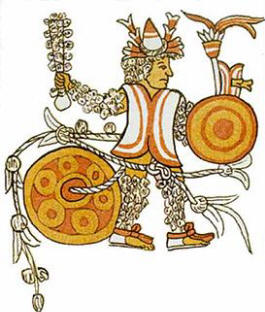 Victim of sacrificial gladiatorial combat, from
Codex Magliabechiano. Note that he is tied to a large stone
and his
macuahuitl (sword/club) is covered with what appears to be
feathers instead of obsidian.
Victim of sacrificial gladiatorial combat, from
Codex Magliabechiano. Note that he is tied to a large stone
and his
macuahuitl (sword/club) is covered with what appears to be
feathers instead of obsidian.
Tezcatlipoca was generally considered the most powerful god, the god of night, sorcery and destiny (the name tezcatlipoca means "smoking mirror", or "obsidian"). The Aztecs believed that Tezcatlipoca created war to provide food and drink to the gods. Tezcatlipoca was known by several epithets including "the Enemy" and "the Enemy of Both Sides", which stress his affinity for discord. Tezcatlipoca had the power to forgive sins and to relieve disease, or to release a man from the fate assigned to him by his date of birth; however, nothing in Tezcatlipoca's nature compelled him to do so. He was capricious and often brought about reversals of fortune. To the Aztecs, he was an all-knowing, all-seeing nearly all-powerful god. One of his names can be translated as "We Who Are His Slaves".
Some captives were sacrificed to Tezcatlipoca in ritual gladiatorial combat. The victim was tethered in place and given a mock weapon. He died fighting against up to four fully armed jaguar knights and eagle warriors.
During the 20-day month of Toxcatl, a young impersonator of Tezcatlipoca would be sacrificed. Throughout a year, this youth would be dressed as Tezcatlipoca and treated as a living incarnation of the God. The youth would represent Tezcatlipoca on earth; he would get four beautiful women as his companions until he met his destiny, in the meantime he walked through the streets of Tenochtitlan playing a flute. On the day of the sacrifice a feast would be held in Tezcatlipoca's honor. The young man would climb the pyramid, break his flute and surrender his body to the priests. Sahagún compared it to the Christian Easter.[21]
Huehueteotl
To appease Huehueteotl, the fire god and a senior deity, the Aztecs had a ceremony where they prepared a large feast at the end of which they would burn captives and before they died they would be taken from the fire and their hearts would be cut out. Motolinía and Sahagún reported that the Aztecs believed that if they did not placate Huehueteotl a plague of fire would strike their city. The sacrifice was considered an offering to the deity.[22]
Tláloc
Tláloc was the god of rain. The Aztecs believed that if sacrifices weren't supplied for Tláloc, rain wouldn't come and their crops wouldn't flourish. Leprosy and rheumatism, diseases caused by Tláloc, would infest the village. Tláloc required the tears of the young as part of the sacrifice. The priests made the children cry during their way to immolation: a good omen that Tláloc would wet the earth in the raining season. In the Florentine Codex, also known as General History of the Things of New Spain, Sahagún wrote:
They offered them as sacrifices to [Tlaloc and Chalchiuhtlicue] so that they would give them water.[23]The Flower Wars
It has often been claimed by scholars that the Aztecs resorted to a form of ritual warfare, the Flower War, to obtain living human bodies for the sacrifices in time of peace. This claim however has been severely criticised by scholars such as Ross Hassig[24][25] and Nigel Davies[26] who claim that the main purpose of the Flower Wars was political and not religious and that the number of sacrificial victims obtained through flower wars was insignificant compared to the number of victims obtained through normal political warfare.
According to Diego Durán's History of the Indies of New Spain, and a few other sources that are also based on the Crónica X, the Flower Wars were originally a treaty between the cities of Aztec Triple Alliance and Tlaxcala and Huexotzingo motivated by a famine in Mesoamerica in 1450. Aztec prisoners were also sacrificed in Tlaxcala and Huexotzingo. The capture of prisoners for sacrifices was called nextlaualli ("debt payment to the gods"). These sources however are contradicted by other sources, such as the Codex Chimalpahin, which mentions "Flower Wars" much earlier than the famine of 1450 and against other opponents than the ones mentioned in the treaty.
Because the objective of Aztec warfare was to capture victims alive for human sacrifice, battle tactics were designed primarily to injure the enemy rather than kill him. After towns were conquered their inhabitants were no longer candidates for human sacrifice, only liable to regular tribute.
Slaves also could be used for human sacrifice, but only if the slave was considered lazy and had been resold three times.[27
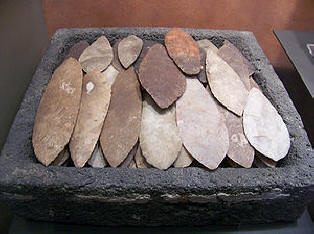
Most of the sacrificial rituals took more than two people to perform. In the usual procedure of the ritual, the sacrifice would be taken to the top of the temple.[28] The sacrifice would then be laid on a stone slab by four priests, and his/her abdomen would be sliced open by a fifth priest with a ceremonial knife made of flint. The cut was made in the abdomen and went through the diaphragm. The priest would grab the heart and tear it out, still beating. It would be placed in a bowl held by a statue of the honored god, and the body thrown down the temple's stairs.[29]
Before and during the killing, priests and audience (who gathered in the plaza below) stabbed, pierced and bled themselves as autosacrifice (Sahagun, Bk. 2: 3: 8, 20: 49, 21: 47). Hymns, whistles, spectacular costumed dances and percussive music marked different phases of the rite.
The body parts would then be disposed of: the viscera fed the animals in the zoo; the bleeding head was placed on display in the tzompantli, meaning 'hairy skulls'.[30] Not all the skulls in the tzompantlis were victims of sacrifice. In the Anales de Tlatelolco it is described that during the siege of Tlatelolco by the Spaniards, the Tlatelolcas built three tzompantli: two for their own dead and one for the fallen conquerors, including two severed heads of horses .
Other kinds of human sacrifice, which paid tribute to various deities, approached the victims differently. The victim could be shot with arrows (in which the draining blood represented the cool rains of spring); die in unequal fighting (gladiatorial sacrifice) or be sacrificed as a result of the Mesoamerican ballgame; burned (to honor the fire god); flayed after being sacrificed (to honor Xipe Totec, "Our Lord The Flayed One"), or drowned.[31]
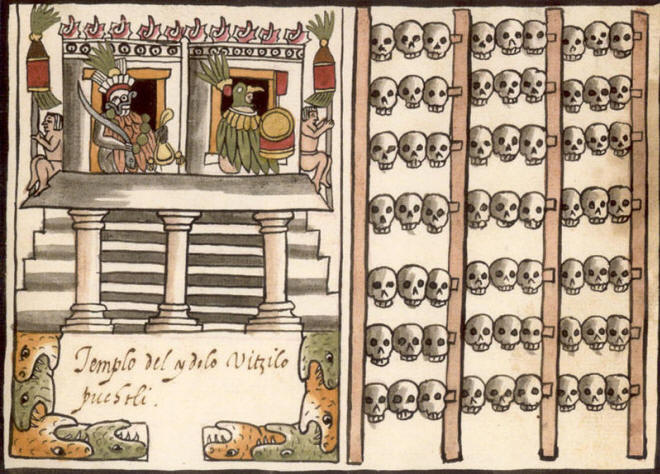
A tzompantli, or skull rack, as shown in the post-Conquest Ramirez Codex
Estimates of the scope of the sacrifices
For the re-consecration of Great Pyramid of Tenochtitlan in 1487, the Aztecs reported that they sacrificed about 80,400 prisoners over the course of four days, though there were probably far fewer sacrifices. According to Ross Hassig, author of Aztec Warfare, "between 10,000 and 80,400 persons" were sacrificed in the ceremony.[32] The higher estimate would average 14 sacrifices per minute during the four-day consecration. As a comparison, the Auschwitz concentration camp, working 24 hours a day with modern technology, approached but did not equal this pace: it executed about 19,200 a day at its peak. Four tables were arranged at the top so that the victims could be jettisoned down the sides of the temple.[33] Nonetheless, according to Codex Telleriano-Remensis, old Aztecs who talked with the missionaries told about a much lower figure for the reconsecration of the temple, approximately 4,000 victims in total.
Michael Harner, in his 1977 article The Enigma of Aztec Sacrifice, estimates the number of persons sacrificed in central Mexico in the 15th century as high as 250,000 per year. Fernando de Alva Cortés Ixtlilxochitl, a Mexica descendant and the author of Codex Ixtlilxochitl, claimed that one in five children of the Mexica subjects was killed annually. Victor Davis Hanson argues that an estimate by Don Carlos Zumárraga of 20,000 per annum is "more plausible."[34] Other scholars believe that, since the Aztecs always tried to intimidate their enemies, it is more likely that they could have inflated the number as a propaganda tool.[35] The same can be said for Bernal Díaz's inflated calculations when, in a state of visual shock, he grossly miscalculated the number of skulls at one of the seven Tenochtitlan tzompantlis. According the Florentine Codex, fifty years before the conquest the Aztecs burnt the skulls of the former tzompantli. Mexican archeologist Eduardo Matos Moctezuma has unearthed and studied some tzompantlis.[36]
Sacrifices were made on specific days. Sahagún, Juan Bautista de Pomar and Motolinía report that the Aztecs had eighteen festivities each year, one for each Aztec month. They clearly state that in those festivities sacrifices were made. Each god required a different kind of victim: young women were drowned for Xilonen; children were sacrificed to Tláloc; Nahuatl-speaking prisoners to Huitzilopochtli, and a single nahua would volunteer for Tezcatlipoca. The Ramírez Codex states that for the annual festivity of Huitzilopochtli more than sixty prisoners were sacrificed in the main temple, and prisoners were sacrificed in other large Aztec cities as well.
Not all sacrifices were made at the Tenochtitlan temples; a few were made at "Cerro del Peñón", an islet of the Texcoco lake. According to an Aztec source, in the month of Tlacaxipehualiztli (from February 22 to March 13), thirty-four captives were sacrificed in the gladiatorial sacrifice to Xipe Totec. More victims would be sacrificed to Huitzilopochtli in the month Panquetzaliztli (from 9 November to 28 November) according to the Ramírez Codex. This would mean a figure as low as 300 to 600 victims a year. There is little agreement on the actual figure due to the scarcity of archeological evidence.
Every Aztec warrior would have to provide at least one prisoner for sacrifice. All the male population was trained to be warriors, but only the few who succeeded in providing captives could became full-time members of the warrior elite. Those who could not would become macehualli, workers. Accounts also state that several young warriors could unite to capture a single prisoner, which suggests that capturing prisoners for sacrifice was challenging.
There is still much debate as to what social groups constituted the usual victims of these sacrifices. It is often assumed that all victims were 'disposable' commoners or foreigners. However, slaves - a major source of victims - were not a permanent class but rather persons from any level of Aztec society who had fallen into debt or committed some crime (see Duran, Book of the Gods and Rites, 131, 260). Likewise, most of the earliest accounts talk of prisoners of war of diverse social status, and concur that virtually all child sacrifices were locals of noble lineage, offered by their own parents (compare Cortes, Letters 105 with Motolinia, History of the Lindies 118-119 and Duran, Book of the Gods, 223, 242).
Likewise, it is doubtful if many victims came from far afield. In 1454, the Aztec government forbade the slaying of captives from distant lands at the capital's temples (Duran, The Aztecs: History of the Indes, 141). Duran' s informants told him that sacrifices were consequently 'nearly always ... friends of the [Royal] House'- meaning warriors from allied states (Duran, The Aztecs: History of the Indies, 141, 198). This probably meant that the average Aztec warrior stood as much chance of procuring a victim as he did of himself becoming one - as the Aztec Emperor reportedly told all captives about to be sacrificed: 'today for you, tomorrow for me'(Tezozomoc Vol.2).
Discussion of primary sources
Early Spanish accounts mention the sacrificial practice of the Aztecs as well as other Mesoamerican cultures in the 16th century. There are numerous depictions of sacrifices in the Mexica statuary, as well as in codices such as the Ríos, Tudela, Telleriano-Remensis, Durán, and Sahagún's Florentine. On the other hand, the pre-Columbian, indigenous codices that depict the rites were not written texts but pictorial and highly symbolic ideographs—the Aztecs did not have a true writing system such that of the Mayas. Bishop Zumarraga (1528-48) burned all obtainable texts in his religious zeal.[37]
For Mesoamerica as a whole, the accumulated archaeological, iconographical and in the case of the Maya written evidence, indicates that human sacrifice was widespread across cultures and periods, dating back to 600 BCE and possibly much earlier. Osteological analyses have also been interpreted as corroborating the texts.[38][39] Pictorial illustrations of sacrifices on Maya ceramics and stelae have also been published.[40]
Accounts from the Grijalva expeditions
In addition to the accounts provided by Sahagún and Durán, there are other important texts to be considered.
Juan de Grijalva, Hernán Cortés, Juan Díaz, Bernal Díaz, Andrés de Tapia, Francisco de Aguilar, Ruy González and the Anonymous Conqueror wrote about the Conquest of Mexico. Martyr d'Anghiera, Lopez de Gomara, Oviedo y Valdes and Illescas, while not in Mesoamerica, wrote their accounts based on interviews with the participants. Bartolomé de Las Casas and Sahagún arrived later to New Spain but had access to direct testimony, especially of the indigenous people. All of these narratives mention and describe the practice of human sacrifice.
Juan Díaz
Juan Díaz, a participant of the 1518 Grijalva expedition, wrote Itinerario de Grijalva before 1520, in which he describes the aftermath of a sacrifice on an island near Veracruz.
Bernal Díaz
Bernal Díaz corroborates Juan Díaz's history:
On these altars were idols with evil looking bodies, and that every night five Indians had been sacrificed before them; their chests had been cut open, and their arms and thighs had been cut off. The walls were covered with blood. We stood greatly amazed and gave the island the name isleta de Sacrificios [Island of the Sacrifices].[41]In The Conquest of New Spain Díaz recounted that, after landing on the coast, they came across a temple dedicated to Tezcatlipoca. "That day they had sacrificed two boys, cutting open their chests and offering their blood and hearts to that accursed idol". Díaz narrates several more sacrificial descriptions on the later Cortés expedition. Arriving at Cholula, they find "cages of stout wooden bars [...] full of men and boys who were being fattened for the sacrifice at which their flesh would be eaten".[42] When the conquistadors reached Tenochtitlan, Díaz described the sacrifices at the Great Pyramid:
| “ | They strike open the wretched Indian's chest with flint knives and hastily tear out the palpitating heart which, with the blood, they present to the idols [...]. They cut off the arms, thighs and head, eating the arms and thighs at ceremonial banquets. The head they hang up on a beam, and the body is […] given to the beasts of prey.[43] | ” |
According to Bernal Díaz, the chiefs of the surrounding towns, for example Cempoala, would complain on numerous occasions to Cortés about the perennial need to supply the Aztecs with victims for human sacrifice. It is clear from his description of their fear and resentment toward the Mexicas that, in their opinion, it was no honor to surrender their kinsmen to be sacrificed by them.[44]
Hernán Cortés
Cortés describes similar events in his Letters:
They have a most horrid and abominable custom which truly ought to be punished and which until now we have seen in no other part, and this is that, whenever they wish to ask something of the idols, in order that their plea may find more acceptance, they take many girls and boys and even adults, and in the presence of these idols they open their chests while they are still alive and take out their hearts and entrails and burn them before the idols, offering the smoke as sacrifice. Some of us have seen this, and they say it is the most terrible and frightful thing they have ever witnessed.[45]The Anonymous Conqueror
The Anonymous Conqueror's Narrative of Some Things of New Spain and of the Great City of Temestitan details Aztec sacrifices.[46] In Chapter XIV he depicts the temple in which men, women, boys and girls were sacrificed.[47] On Chapter XXIV the Anonymous Conqueror repeatedly claims that the Aztecs were cannibals, sodomites, alcoholics and polygamists.[48] The original Spanish text is lost. The description of the temple was published in the 1556 Ramusio Italian edition.
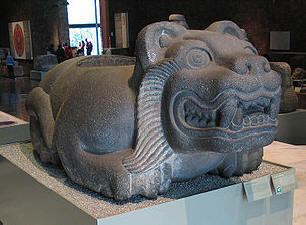 A jaguar-shaped
cuauhxicalli in the
National Museum of Anthropology. This altar-like stone
vessel was used to hold the hearts of sacrificial victims. See
also
chacmool.
A jaguar-shaped
cuauhxicalli in the
National Museum of Anthropology. This altar-like stone
vessel was used to hold the hearts of sacrificial victims. See
also
chacmool.
Assessment of the practice of human sacrifice
Human sacrifice was nothing new when the Aztecs arrived to the Valley of Mexico, nor was it something unique to pre-Columbian Mexico. Other Mesoamerican cultures, such as the Tarascans and Toltecs, performed human sacrifices as well. Although the extent of human sacrifice is unknown among several Mesoamerican civilizations, such as Teotihuacán,[49] what distinguished Maya and Aztec human sacrifice was the importance with which it was embedded in everyday life.
Diego Durán states that Aztecs made "indifferent or sarcastic remarks" when the Spaniards severely criticized the rite. In his Book of the Gods and Rites some of the Nahuas even ridiculed the Christian sensibilities. Instead, they asked the Spaniards to applaud:
The sacrifice of human beings […], the honored oblation of great lords and noblemen. They remember these things and tell of them as if they had been great deeds.[50]Although Aztec accounts mention some victims who wept, 'faltered... weakened' or 'lost control of their bowels' when going to be sacrificed (Sahagun Bk 2: 81), this reaction does not seem to have been the norm, as when this occurred, it was viewed as a bad omen (Duran, Book of the Gods and Rites, 132), and a tetlazolmictiliztli ('insult to the gods')(Duran, Book of the Gods and Rites, 132). Such victims were hurriedly taken aside and slain amidst the congregation's sarcastic jeers of '(the victim has) quite acquitted himself as a man'(Sahagun Bk 2:21). Contrary to popular perceptions of Aztec victims being terrified of their fate, even the Conquistadors Cortes and Alvarado found that those they freed 'indignantly rejected [the] offer of release and demanded to be sacrificed.'(Bernal Diaz, The Conquest of New Spain,159).
What we can glean from all this is that the sacrificial role entailed a great deal of social expectation and a certain degree of acquiescence. Sahagun's informants told him that key roles were reserved for persons who were considered 'charming...quick..dances with feeling.. without [moral] defects ... of good understanding ... good mannered'(Sahagun Bk 2: 24: 68-69). For many rites, the victim had such a quantity of prescribed duties that it is difficult to imagine how the accompanying festival would have progressed without some degree of compliance on the part of the victim. For instance, victims were expected to bless children, greet and cheer passers-by, hear people's petitions to the gods, visit people in their homes, give discourses and lead sacred songs, processions and dances (Sahagun Bk 5: 8; Bk 2: 5:9; Bk 2:24:68-69). The works of Clendinnen and Brundage imply that only a few select victims had this kind of role, but the Florentine Codex and Duran both make no such distinctions, stating that 'those who had to die performed many ceremonies... [and] these [pre-sacrificial] rites were performed in the case of all the prisoners, each in turn.'(see Sahagun Bk 2:5:9 and Duran, Book of the Gods...p. 112).
It should also be remembered that these sacrifices were ritualistic and symbolic acts accompanying huge feasts and festivals. Victims usually died in the "center stage" amidst the splendor of dancing troupes, percussion orchestras, elaborate costumes and decorations, carpets of flowers, crowds of thousands of commoners, and all the assembled elite.
This might explain why Aztec texts frequently refer to human sacrifice as neteotoquiliztli, 'the desire to be regarded as a god'(Duran, Book of the Gods and Rites, 177 Note 4). For each festival, at least one or more victims took on the paraphernalia, habits and attributes of the god or goddess whom they were dying as. Particularly the young man who was indoctrinated for a year to submit himself to Tezcatlipoca's temple was the Aztec equivalent of a celebrity or rock star, being greatly revered and adored to the point of people "kissing the ground" when he passed by, as Sahagún put it.[51]
This practice was known as becoming an ixiptla - namely, the god's representative, image or idol. Ixiptla was the same term used for wooden, stone and dough images of gods. Interestingly, Aztec texts rarely differentiate between human ixiptla and wooden or stone ixiptla. In fact, so elaborately costumed and painted were human ixiptla that even the congregation was unsure which were human and which were stone or wood (Duran, Book of the Gods and Rites, 102). When a victim appeared in full regalia before the congregation, it was said that the divinity had been given 'human form'- that the god now had an ixitli (face)(Duran, Book of the Gods..., 72-73). Duran says such victims were'worshipped... as the deity'(Duran, Book of the Gods and Rites, 42,109,232) or 'as though they had been gods'(Sahagun, Florentine Codex Bk 2: 226, 238-239) (-the original Nahuatl term being nienoteoti'tzinea, literally, 'I consider him a god')(Clavigero, 98). Even whilst still alive, these victims were honoured, hallowed and addressed (like gods) as 'Lord' and 'Lady'(Duran, Book of the Gods and Rites.., 189) Posthumously, their remains were treated as actual relics of the gods which explains why victims' skulls, bones and skin were often painted, bleached, stored and displayed, or else used as ritual masks and oracles. For example, Diego Duran's informants told him that whoever wore the skin of the victim portraying god Xipe considered himself 'divine'(Duran, Book of the Gods and Rites..176).
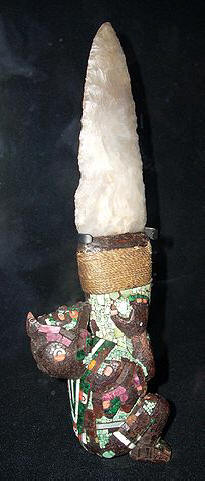 Proposed explanations of Aztec human sacrifice
Proposed explanations of Aztec human sacrifice
Aztec or Mixtec sacrificial knife, probably for ceremonial use only, in the British Museum.[52]
Scholars Michael Harner[4] and Marvin Harris have argued that the motivation behind human sacrifice among the Aztecs was actually the cannibalization of the sacrificial victims. While there is universal agreement that the Aztecs practiced human sacrifice, there is a lack of scholarly consensus as to whether cannibalism was widespread. At one extreme anthropologist Marvin Harris, author of Cannibals and Kings, has propagated the claim, originally proposed by Harner, that the flesh of the victims was a part of an aristocratic diet as a reward, since the Aztec diet was lacking in proteins. This claim has been refuted by Bernard Ortíz Montellano who, in his studies of Aztec health, diet, and medicine,[53][54] demonstrates that while the Aztec diet was low in animal proteins, it was rich in vegetable proteins.
The political explanation
The high-profile nature of the sacrificial ceremonies indicates that human sacrifice played an important political function. The Mexica used a sophisticated package of psychological weaponry to maintain their empire, aimed at instilling a sense of fear into their neighbours. The Aztecs controlled a large empire of tribute paying vassal tribes. The population of native Aztecs was very small compared to the population of the area they controlled. The Aztecs were vulnerable - they would have been easily outnumbered had their vassal tribes formed alliances and rebelled. To sow dissention among the vassals the Aztecs demanded human victims as part of the annual tribute. The vassals would raid each other to capture prisoners. This encouraged animosity between the vassals and strengthened Aztec political central rule. This was a method of political control which was innovative and perhaps unique in human history.
European empires, in contrast, were typically secured through the creation of garrisons and installation of puppet governments in conquered towns or settlements. The Mexica used human sacrifice as a weapon of terror even against the Spanish conquistadors, whose fallen victims were sacrificed and sometimes skinned and their bloody heads placed at the tzompantli. From across the empire even the chiefs of enemy towns were invited, or in the case of tributary towns obliged, to attend sacrificial ceremonies in Tenochtitlan. Their refusal would be considered an act of defiance against the Mexica.
The psychological explanation
For Lloyd deMause it is significant that the victims were invested of a profound cosmological meaning. According to him and a minority of academics who subscribe to an alternate school of thought, "psychohistory", human sacrifices, including sacrifices in Mesoamerica, were an unconscious form of response to the traumatogenic modes of childrearing.[55] DeMause in particular considers the Aztecs' practice of sacrifice as displacement.[56]

